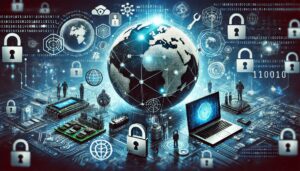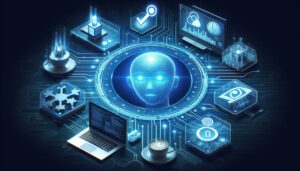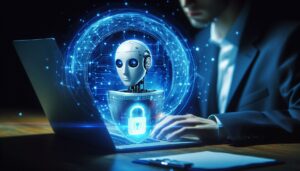Introduction
Artificial Intelligence (AI) refers to the application of human intelligence by machines so that they can perform the tasks that typically requires learning, reasoning, problem solving, and decision making. AI has rapidly evolved to a transformative force across industries due to the advancement in computer technology, data availability, and algorithm development. AI’s advance features and it’s adaptability has allowed it make impact on many industries like healthcare, finance, manufacturing, retail, transportation, cyber security and many more.

Now the world has changed completely because of AI and it’s growing capabilities due to which it became the necessity for organizations to remain competitive in this fast growing technology. It’s role in cybersecurity has two faces, first one that offers great advancement in threat detection as well as simultaneously posing new risks and vulnerabilities.
Before knowing the impact of AI on cybersecurity, firstly understand the importance of cybersecurity:
Importance of Cybersecurity in the Digital Age
Cybersecurity has become a critical necessity in this interconnected world where digital technologies connect everything from personal communication to global economies. The risk of cyber threats has increased due to the vast majority data, transactions and operations taking place online. That’s why cybersecurity is crucial in this digital age.

In today’s world, the prime targets for hacker are personal, financial and organizational data. They always try to steal your personal information like your images, videos, contacts, accounts and many more. Data breach can lead to identity theft, financial loss and damage to reputations. It can also affect sectors like healthcare, transportation, banks and online industries that are heavily dependent on digital systems. Due to the growth of technology every industries has adapted online technologies to become fast and more efficient. Cyberattacks on these system can disrupt essential services which can cause widespread societal and economic harm.
Cybercriminals continually innovate and leveraging advanced technologies like AI and machine learning so that they can create sophisticated attacks. That’s why cybersecurity must evolve at the same pace to counter threats such as ransomware, phishing and advanced persistent threats (APTs). A cyberattack can distort operations, leading to downtime, loss of revenue, and can erode customer trust. With increasing these concerns over data privacy, cybersecurity helps the individuals to protect them from cyberattacks ensuring personal data is stored and processed securely.

As society becomes more dependent on digital technologies trust in secure systems is high-priority. If the environment of your system is not secure then you should take some serious steps like two-step verification to protects yourself from any attacks. Effective cybersecurity reassures users that their data and interactions in the digital world are safe.
Dual-Sided Nature of AI
Artificial Intelligence (AI) has emerged as both a powerful friend and a potential threat in the field of cybersecurity. It’s dual sided nature arise from its ability to enhance defense mechanism while simultaneously being exploited by malicious person.
AI as a Tool for Defense
Real Time Threat Detection refers to the continuous and immediate monitoring, identification and response to the potential cybersecurity threats when the happen. AI powered systems analyze large amount of data very fast and identify the patterns and anomalies the helps to indicate an attack. There are many tools which helps like intrusion detection system (IDS) and security investment and event management (SIEM) platforms use AI to detect malware, phishing attempts and unauthorized access in real time. These tools notified you whenever they observe unusual and suspicious activity.

AI predicts cyberattacks and risk by analyzing historical data and identifying patterns. Whenever these tools found any old pattern and suspicious activity, they send a alert message so that you can increase your security steps. If someone trying to crack your passwords and if they fail once you every time see a security alerts which need these tools to identify. This proactive approach helps the organization to strengthen their defenses before vulnerabilities took place. There is also a features of automatic response to the threats by using AI which helps to block suspicious activity and can only be normalized by its owner.
The presence of AI-driven biometric systems such as facial recognition or behavioral analytics helps to add a layer of security to systems. These systems ensures that no other person can open your system without your presence and the continuous monitoring ensures that access remains secure even after initial authentication.
AI as a Potential Risk
AI strengthens cybersecurity as well as introduces vulnerabilities and new threats. Many times hacker use AI to generate fake voices and videos which seems like a real person but created using AI and this is called Deepfake Phishing. In these frauds, they often use your social media images and videos to swipe your face with some character of that video which sometimes fits and perfect and becomes difficult to identify that this is fake or real. Currently, there are many voices and videos goes viral on social media in which scammers call and ask for money by using these fake videos.
Attackers can use AI automated systems in wrong way in which they can modify AI-based spam filter into allowing harmful emails and messages which may result in attacks on your systems if you click some doubtful link. They can manipulate AI models which may result in incorrect predictions by the system.

Many organizations rely heavily on AI systems to manage security operations without adequate human oversight or complementary safeguards. This heavily dependency on AI systems can create vulnerabilities and blind spots. Sometime organizations assume that AI is always correct and that’s why they neglect to implement other essential security measures which may result in heavy loss or may people loose trust. Since, all these AI systems work according to the availability of data which can be compromised by the attackers and these systems may behave unpredictively.
Conclusion
Without any doubt Artificial Intelligence in cybersecurity has dramatically changed the face of how we approach digital defense. The power of analyzing enormous datasets, the detection of real-time threats, and predicting vulnerabilities with AI, as a core foundation for modern cybersecurity has taken it to the top of its class. Yet this powerful technology comes with many challenges including the risk of adversarial attacks and over-reliance. Cybercriminals also take advantage of AI in cybersecurity thereby making the impact of AI in cybersecurity profound yet complex.

The whole prospect and peril of using AI can therefore only be seized and minimized properly when there exists an equilibrium method combining AI-enabled automation with expert humans, innovational investment as a continuation process, and encouraging global engagement with the current emergent danger that Artificial Intelligence raises to the overall process. So the future would likely be promising regarding digital protection once Artificial Intelligence and cyber security mutually relate to change their future accordingly.
For more fascinating insights into unique topics, check out our blog about “Uranium Glass” and discover the surprising history, glowing properties, and allure of this extraordinary material!
